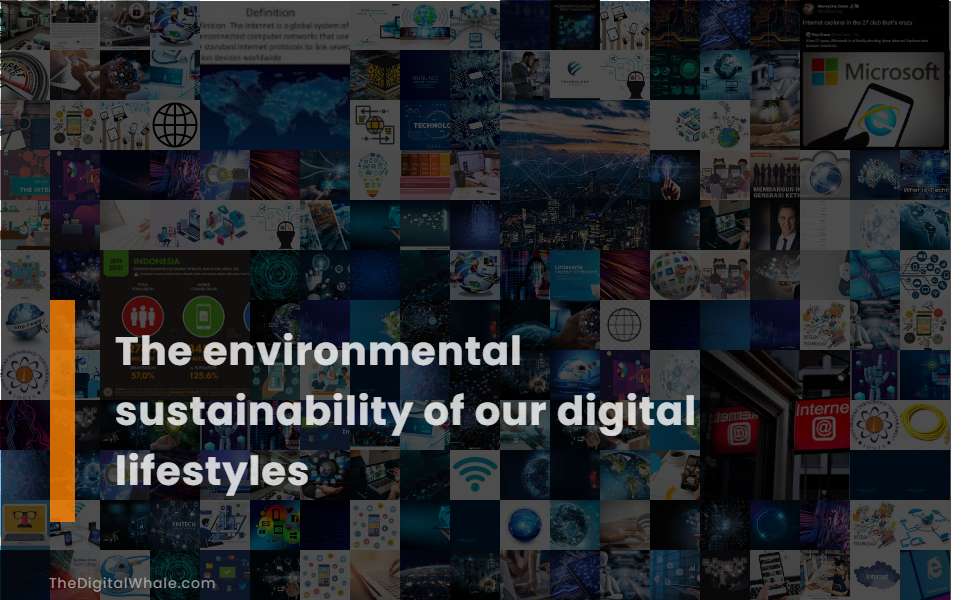The Environmental Sustainability of Our Digital Lifestyles
What are some ways you can become more sustainable in your lifestyle? Is it sustainable to be constantly using the Internet? Let's find out more about The Environmental Sustainability of Our Digital Lifestyles.

Digital technologies can reduce global greenhouse gas emissions by 20% by 2030.
Digital technologies have the potential to reduce global greenhouse gas emissions significantly, with estimates suggesting they could cut emissions by up to 20% by 2030, particularly in the energy, materials, and mobility sectors, thereby supporting the transition to a Net-Zero Emissions future.
Energy-efficient devices and green data centers are crucial for a sustainable digital future.
Energy-efficient devices and green data centers are essential for a sustainable digital future, as they reduce global greenhouse gas emissions, utilize renewable energy sources, and implement efficient cooling and waste management systems to minimize environmental impact. These technologies help in creating a Digital Ecosystem that is in harmony with the natural world.
Proper e-waste management and recycling are essential to mitigate environmental harm.
Proper e-waste management and recycling are crucial to mitigate environmental harm, as they prevent the release of hazardous materials like lead, mercury, and cadmium into the environment, and help in recovering valuable materials from discarded devices. For more insights on sustainable practices, visit the Eco-Friendly Solutions page. Through responsible recycling practices, we can significantly reduce the negative impact on our planet and contribute to a more sustainable future.
Smart home automation and ethical consumerism empower sustainable choices.
Smart home automation and ethical consumerism play crucial roles in promoting sustainable choices by optimizing energy consumption, managing e-waste responsibly, and encouraging the selection of eco-friendly tech products, thereby reducing the environmental impact of our digital lifestyles. By supporting environmentally responsible products, promoting resource conservation, and advocating for transparent and accountable supply chains, these strategies empower individuals to contribute to a more sustainable and socially just society. For further insights, the Sustainable Mother Earth website highlights the significant impact of ethical consumerism, guiding consumers towards making informed decisions for a better planet.
The internet accounts for around 4% of global carbon emissions, similar to the aviation industry.
The Internet accounts for around 4% of global carbon emissions, a figure equivalent to the output of the entire aviation industry. This is primarily due to the electricity used for powering devices, data storage, and network infrastructure, which is often sourced from fossil fuels. To learn more about this pressing issue and explore ways to mitigate the environmental impact of the digital sphere, you can read the comprehensive insights on [Web Sustainability](https://developer.mozilla.org/en-US/blog/introduction-to-web-sustainability/) provided by the Mozilla Developer Blog.
Related:
What are the three biggest ways technology is transforming the workplace? How does technology impact the way work is done and the way employees communicate? Let's find out more about Technology In the Workplace- Its Changing Role.
Data centers and cloud computing require significant energy and water resources.
Data centers and Cloud Computing require substantial energy and water resources, contributing to significant greenhouse gas emissions, water consumption, and land use. However, transitioning to renewable energy sources, energy-efficient equipment, and sustainable water management can help mitigate these environmental impacts. For more insights into the sustainability benefits and strategies associated with cloud computing, you can explore the comprehensive information provided by TechTarget. By adopting these measures, the industry can significantly reduce its environmental footprint while continuing to support technological advancements.
Device manufacturing involves material extraction and chemical pollution, harming environments and communities.
Device manufacturing involves the intensive extraction of non-renewable resources such as oil and metals, leading to deforestation, soil erosion, water pollution, and loss of biodiversity. This process also releases hazardous chemicals and greenhouse gases, posing significant environmental and health risks. To better understand these impacts, initiatives like the European Projects focus on analyzing the life cycle of devices, allowing us to comprehend the overarching environmental footprint of digital technologies and guide toward more sustainable practices.
Global e-waste generation is rising, projected to reach 82 million tonnes by 2030.
Global e-waste generation is rising at an alarming rate, projected to reach 82 million tonnes by 2030, a 33% increase from 2022, with only about 22.3% of the generated e-waste being properly collected and recycled. This poses significant health and environmental hazards due to the presence of toxic substances like mercury. For more information, you can read the full article on E-Waste Recycling.
Less than 25% of global e-waste is properly collected and recycled.
With the ever-increasing demand for electronic devices, our planet is facing a significant challenge in managing the resulting electronic waste. Alarmingly, less than 25% of global e-waste is properly collected and recycled, which underscores a troubling disconnection between e-waste generation and recycling efforts. In 2022, only 22.3% of total electronic waste was documented as formally collected and treated in an environmentally sound manner, according to a revealing report from Earth.org. This data highlights the urgent need to bridge the gap in e-waste management strategies to mitigate environmental hazards and promote sustainable consumption.
Sustainable web design and development can reduce carbon emissions and resource usage.
Sustainable web design and development can significantly reduce carbon emissions and resource usage by optimizing images, minimizing code, using sustainable hosting services, and implementing efficient design principles. These principles, such as minimalistic layouts and proper coding techniques, lead to faster loading times and a better user experience while minimizing environmental impact. For a deeper understanding of these concepts, you may explore Sustainable Web Design where these practices are discussed in detail.
Related:
What are some tips for increasing your LinkedIn search visibility? How to make the most of LinkedIn, your go-to networking site for specialized talent? Let's find out more about How To Make the Most of Linkedin.
